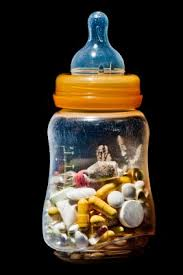It's a New Day in Public Health.
The Florida Department of Health works to protect, promote, and improve the health of all people in Florida through integrated state, county, and community efforts.
Neonatal Abstinence Syndrome and Opioid Use Disorder
Contact the Maternal and Child Health Section
- 850-245-4465
-
Fax
850-245-4047
What is Neonatal Abstinence Syndrome?
Neonatal abstinence syndrome (NAS) is a collection of signs and symptoms that indicate a newborn is experiencing withdrawal from exposure to addictive opiate drugs while in the mother’s womb. The most common opiate drugs that are associated with NAS are heroin, codeine, oxycodone (oxycontin), fentanyl, methadone and buprenorphine. The occurrence of NAS is not limited to newborns of moms with illicit drug use, but could also be a result of pregnant women using prescribed medications for the treatment of pain, depression, and anxiety.
 When your baby is born, your baby is still dependent on the drug. Because your baby is no longer getting the drug through you, the mother, via the placenta, symptoms of withdrawal may occur. Although NAS is associated the most with opiate drugs, babies exposed to alcohol, tobacco, and other drugs can also have symptoms of withdrawal.
When your baby is born, your baby is still dependent on the drug. Because your baby is no longer getting the drug through you, the mother, via the placenta, symptoms of withdrawal may occur. Although NAS is associated the most with opiate drugs, babies exposed to alcohol, tobacco, and other drugs can also have symptoms of withdrawal.
NAS is treatable. Early identification can help you and your baby receive the right treatment
What is Opioid Use Disorder (OUD)?
Opioid Use Disorder is a treatable disease that can be caused by frequent opioid use, both prescription and non-prescription. It is sometimes called opioid addiction. Symptoms of OUD may include:
- Feeling a strong desire for opioids
- Feeling unable to stop or reduce opioid use
- Needing more opioids to get the same effect
- Spending a lot of time trying to find and use opioids
- Feeling unwell after stopping or reducing use
OUD in pregnancy increases the risk of poor maternal and neonatal outcomes, including NAS.
Talk to your healthcare provider about the best treatment plan for you and your baby.
It is important to be honest with your obstetrician (OB) or nurse midwife and with your baby’s pediatrician about what you were taking during your pregnancy (prescription medications, illicit drugs, tobacco, or alcohol), how much you were using and how often so the doctor can support or link you to treatment and make sure there are preparations to treat you and your baby for withdrawal symptoms if needed. Because symptoms may not show up for days after delivery, it is important to watch your baby closely and call your baby’s pediatrician right away if you notice any of the symptoms of withdrawal.
What are the symptoms my baby may experience if he/she goes through withdrawal?
Symptoms of withdrawal may depend on the drug involved and the last time the drug was used. Symptoms can begin within 1-3 days after birth, or may take up to 10 days to appear. Symptoms may include:
- Blotchy skin coloring (mottling)
- Diarrhea
- Excessive crying or high-pitched crying
- Excessive sucking
- Fever

- Hyperactive reflexes
- Increased muscle tone
- Irritability
- Jitteriness
- Poor feeding
- Rapid breathing
- Seizures
- Sleep problems
- Slow weight gain
- Stuffy nose, sneezing
- Sweating
- Trembling (tremors)
- Vomiting
What else should I know?
- It is important to only take medication during your pregnancy that your obstetrician or nurse midwife says is okay to take during pregnancy.
- Never take any illicit drugs, prescription drugs that were not prescribed to you or drink alcohol, smoke or be around others who are smoking during your pregnancy.
- If you are addicted to prescription medication, alcohol, tobacco, or illicit drugs, get treatment before becoming pregnant and as soon as you find out that you are pregnant.
- Home visiting programs, like Healthy Start, can provide support and information on resources available in your community to assist you in pregnany and after your baby is born.
- Work with your provider or home visiting program to develop a Plan of Safe Care to ensure you and your baby get the help you need after delivery. Keep this plan up-to-date and share with the hospital and other organizations involved in your care.
- Pregnant women who use certain drugs during pregnancy may have a baby who cries more than other babies. It is easy to become frustrated when your baby is crying. Shaken baby syndrome is 100% preventable and there are ways to deal with your frustrations.
- Parents are an important part of the treatment plan. For example, your doctor may recommend breastfeeding as a way to help your baby through withdrawal.
- Print a brochure to keep on your refrigerator or in your nursery for when you need to remember how to cope with your child’s crying. It may also be a good idea to print a brochure with information for anyone who will care for your child like a child care provider. Coping with Crying Brochure
- For further assistance, the Crisis Hotline is available at 1-800-FLA-LOVE.
Resources
Born Drug Free Florida: GET HELP 1-800-945-1355
This is an initiative to raise awareness about babies being born exposed to prescription drugs. The campaign educates expectant mothers about the importance of discussing prescription drug abuse with their doctors and to offer assistance to the women.
The Family Health Line at 1-800-451-2229
Pregnancy Calendar: These slides show the stages of pregnancy. By looking at the parts of the fetus that are developing, you can see what parts of the fetus can be damaged by smoking, drinking or using certain drugs while pregnant.




Connect with DOH